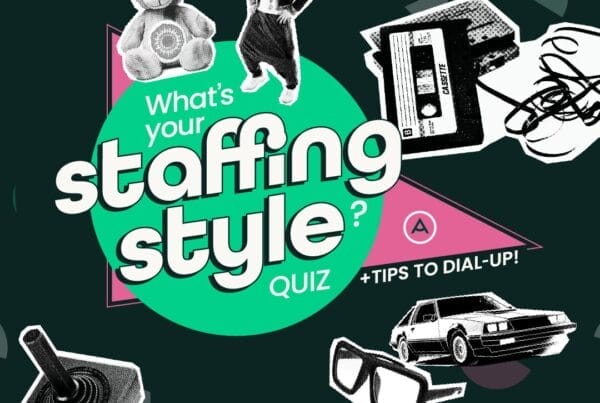Even in the best of times, it’s frustrating when candidates get stuck in the recruitment pipeline. For healthcare, and especially during a talent shortage, this is more than frustrating. Short staffing is hard on your business and dangerous for staff and patients alike. Reducing your time-to-hire isn’t always easy, but you can tailor your recruitment strategy to shave days off your process.
What Is Time-to-Hire?
Your time-to-hire is an important metric for understanding whether your hiring process is efficient. It covers the moment you contact a candidate until the moment they accept your offer.
There are a lot of reasons time-to-hire might become drawn out. If you have multiple interviews, numerous screening phases, or a long period of deliberation, these will all add up to a longer time-to-hire. Sometimes unexpected issues can also contribute to this, like falling out of touch with a candidate or needing to go through multiple rounds of negotiation.
There’s nothing inherently wrong with taking your time to screen a candidate. But if you’re trying to fill an opening quickly, you’ll probably need to find ways to shorten this period. The trick is to do this without sacrificing the quality of your screening process.
Understanding Time-to-Hire and Time-to-Fill
Time-to-hire refers to the time it takes to move a candidate through your recruiting pipeline. Time-to-fill, meanwhile, refers to the whole time it takes to actually fill the role. That’s the whole time you had an open position, even before you started talking to new candidates.
These two concepts are obviously linked. If you can shorten your hiring process (i.e., your time-to-hire) you’ll also shorten the length of time you have an opening (i.e., your time-to-fill).
Why does this matter? These two metrics give different insights into your hiring process. Time-to-hire can tell you if you’re getting stuck on interviews, screening, or getting candidates to accept an offer. A long time-to-fill suggests that you might have problems finding candidates in the first place.
What’s the Average Time-to-Hire in Healthcare?
The average time to fill a position in healthcare is a staggering 49 days. By comparison, the average across industries in the United States is only 36 days.
Why is the healthcare time-to-fill so much higher than the average? It’s likely a combination of reasons. Time-to-fill is almost double time-to-hire in healthcare. This suggests that candidate sourcing is a big part of the problem. That’s no surprise—healthcare is working through a well-documented talent shortage. There are simply not enough people looking for jobs.
Making things even more complicated, many healthcare organizations struggle with antiquated technology that may not stand up to the industry’s demands. Healthcare recruiters need to automate steps where they can, and not every system supports this. With too few candidates and inefficient systems, you get long, often painful hiring processes.
How to Improve Your Time-to-Hire in Healthcare
Being strategic about the technology you use can make a huge difference to the time it takes you to fill a vacancy.
Get Creative With Candidate Sourcing
Part of improving your time-to-fill is, quite simply, recruiting more widely. One of the things that makes healthcare recruiting unique is the relatively high ratio of openings to applicants—in other words, there are more jobs than candidates. This tends to make healthcare recruiting highly competitive, but it also points to an opportunity to recruit from other industries and to focus on attracting candidates who are underrepresented in the industry.
Traditional methods of recruiting might not be enough to pull in passive candidates. Healthcare recruiters should also consider focusing on social media recruiting, incentivizing referrals from current employees, and running awareness campaigns for college (or even high school) students. If you’re using recruiting software to automatically distribute job posts to relevant sites, you may have the flexibility to spend time on these less conventional recruiting tactics.
Implement 1-Click and Mobile-First Apply
To recruit in healthcare successfully, you need to be able to do two things: find qualified candidates, and hire them quickly. Speed is vital in an industry with such a high level of competition. If you’re not able to onboard a new hire rapidly, it’s inevitable you’ll see some candidates take jobs with other organizations.
One way you can speed up your hiring process is by making the whole application process mobile-friendly. Setting up quick-apply or 1-click apply will also bring in more candidates, including job seekers who are applying for new jobs in between shifts. Single-click applications are especially effective if you’re already using an applicant tracking system capable of verifying through credentials. That way, you’re not just getting more applicants—you’re getting more applicants who are actually qualified.
Be Upfront About Company Culture
Whether you’re focused exclusively on traditional job postings or if you have a whole collection of recruiting strategies, try to be transparent about your culture. Social media can be a great place to do this. But even without a social media presence, you can demonstrate your culture through career pages, your website, and individual job posts.
The period between sending out a job offer and receiving an offer can vary greatly depending on the position and candidate. Ideally, you want to offer a job to someone who is going to accept it. You can save both yourself and your candidates a lot of time by trying to answer their questions early in the recruitment process. Some of those questions (What is it like to work here? Will I fit in? Have support? Be safe?) can be implicitly answered by making your values clear. In other words, giving your candidates an early understanding of your culture can also help them make a decision quicker.
Standardize Candidate Communication
A more standard recruiting process is a good idea in general. Making sure everyone involved with hiring approaches it the same way will help you track recruitment metrics, which can then show you what’s working and what needs to change. A great place to start standardizing your process is in your candidate communications.
Keeping candidates engaged tends to speed up hiring and reduce the number of interview no-shows. If you have software that supports automatic messages, you can schedule follow-ups to send before and after an interview. Otherwise, it’s still helpful to have a series of emails or texts drafted in advance. This will let you control your voice, even if many people are sending messages. You’ll stay top-of-mind for candidates with a consistent flow of communication.
Efficient Recruiting With Apploi
Apploi is here to simplify your healthcare staffing. We help employers source candidates, streamline hiring, and onboard new recruits. With Apploi’s suite, create automatic digital employee records, track important documents, automate workflows, and get alerts when paperwork is missing or soon to expire.
Interested in learning more about how you can recruit, hire, and onboard healthcare staff quickly? Contact us today for a free demo of our end-to-end talent management solution and learn more on our website about how Apploi helps you keep candidates engaged.





